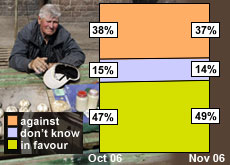Reputation in Poland built on aid projects

Poland is due to receive SFr489 million ($383 million) from Switzerland as part of an effort towards reducing social disparities within the enlarged European Union.
In the 1990s the country was the main beneficiary of Swiss aid following the collapse of the Communist system in eastern and central Europe.
Swiss voters have the final say on the new financial contribution in a nationwide ballot on November 26. This is part of a SFr1 billion package that Switzerland is planning for the ten countries which joined the EU in 2004.
Switzerland spent about SFr154 million on a series of projects in Poland in a bid to support economic and social reforms, combat poverty and establish democratic institutions during the transition to a market economy.
None of the more than 20 countries between the Baltic Sea and central Asia received nearly as much financial or technical support during the same period.
“Poland was a focus country of our cooperation programmes for its sheer size and importance and because of striking economic inequalities in the country,” says Axel Heiri of the Swiss Agency for Development and Cooperation (SDC).
Detailed records of the aid programmes to the eight countries, including Poland, don’t appear to be easily accessible but Heiri remembers keeping an archive of cardboard boxes… in a bathtub.
“Our office for aid to eastern Europe was in an apartment in Bern. This reflects somehow the pioneer spirit of those days,” he says.
Wholesale market
Eight years on as the government decided to shift the focus of its aid programme from eastern Europe to the Balkans and the former Soviet republics, the Swiss authorities published a booklet summing up their experience.
“We look back with satisfaction on the achievements – even if not all the programmes were as successful as we hoped,” the editorialist wrote in 1998.
One of the internationally acclaimed Swiss success stories in Poland was the creation of a wholesale market for vegetable and flowers in Poznan, a city in the west of the country.
It is one of the few projects which is making a profit 15 years later, and which has expanded and survived in a competitive environment, according to Heiri. The aim was to replace the poorly organised street markets at the time and set up transparent structures for trade in agricultural products.
“We found a perfect Swiss solution for the construction. Despite the complex legal structure the handling of the market is simple and functional,” says Heiri.
Incubators
Other successful projects included a health project to reduce infant mortality in the Katowice region. The area in Upper Silesia was the centre of Poland’s heavy industry and suffered from extreme pollution levels in the air and the water.
Switzerland provided incubators and other badly needed medical equipment for newborn babies and mothers in 144 outpatient clinics and hospitals of the region. It also organised specific basic and high-level training for medical and technical staff.
Heiri who visited Katowice a year ago is pleased to see that Swiss aid has had an impact and still does, but also that it has served as a model to other eastern European countries. “Local people still remember the Swiss initiative.”
Swiss aid in Poland also included regional programmes to combat poverty in remote rural areas by providing credits for small enterprises. It also went towards culture, research and education, notably a media training project organised by Swiss Radio International.
Heiri says the success of a certain aid programme was often a combination of several factors, including close cooperation with local staff, a careful assessment of the projects and strong personal involvement by project leaders.
He believes there is some logic in the bulk of the SFr1 billon fund for the new EU members going the Poland. “Switzerland has an excellent reputation in the region and it could become tarnished if voters came out against the cohesion payment,” he adds.
swissinfo, Urs Geiser
Since the 1990s the Swiss parliament approved credits of SFr3.5 billion for more than 1,000 projects in 23 countries in eastern Europe and the former Soviet Union.
In 1998 the focus of the traditional aid to eastern Europe, provided jointly by the Swiss Agency for Development and Cooperation (SDC) and the State Secretariat for Economic Affairs (Seco), shifted from central Europe to the Balkans the central Asian republics.
The main purpose of the aid to eastern Europe is to help the former Communist states adapt to market economies and develop democratic structures.
The Swiss government says the SFr1 billion payment for the ten new EU member states is its contribution towards reducing inequalities in the enlarged EU.
Non-EU member Switzerland has concluded 16 bilateral treaties with Brussels covering trade, labour, transport, taxation, immigration and customs.
Swiss eastern Europe aid to Poland (since 1990s): SFr154 million.
Swiss EU cohesion contribution to Poland: SFr489 million.
Swiss exports to Poland 2005: SFr1.4 billion; 1989: SFr334 million
Swiss imports from Poland 2005: SFr808 million; 1989: SFr119 million
Population of Poland: 38.6 million; Switzerland: 7.5 million

In compliance with the JTI standards
More: SWI swissinfo.ch certified by the Journalism Trust Initiative













You can find an overview of ongoing debates with our journalists here . Please join us!
If you want to start a conversation about a topic raised in this article or want to report factual errors, email us at english@swissinfo.ch.